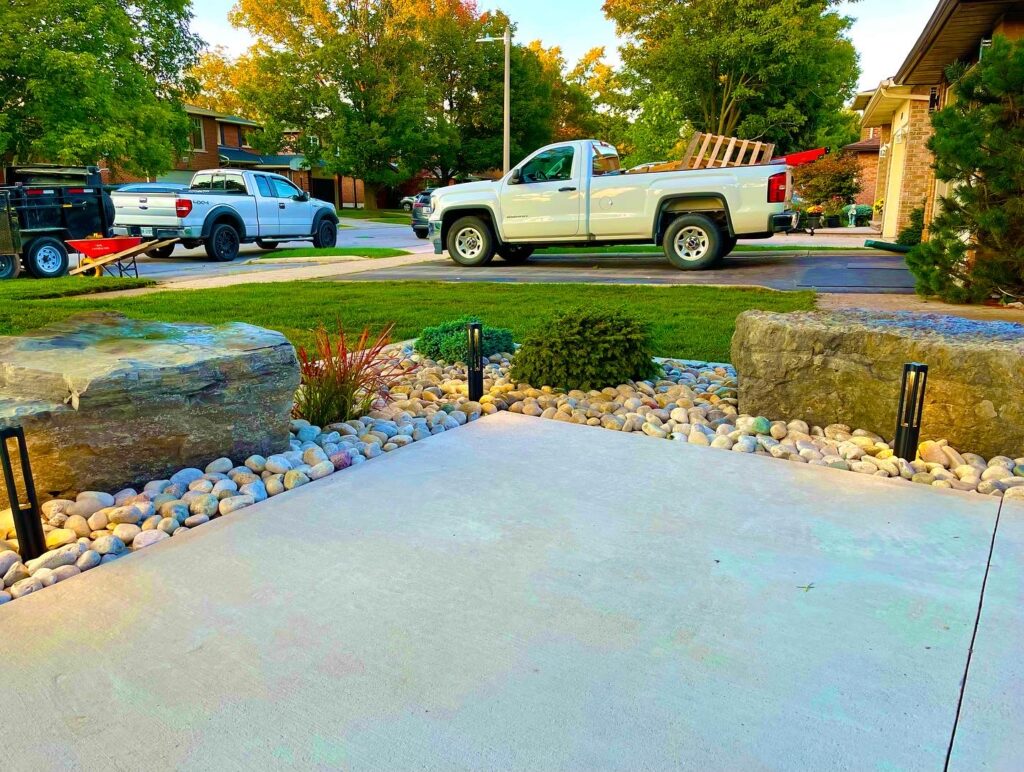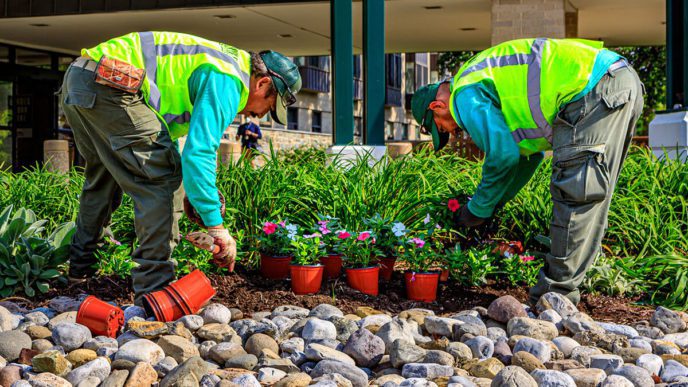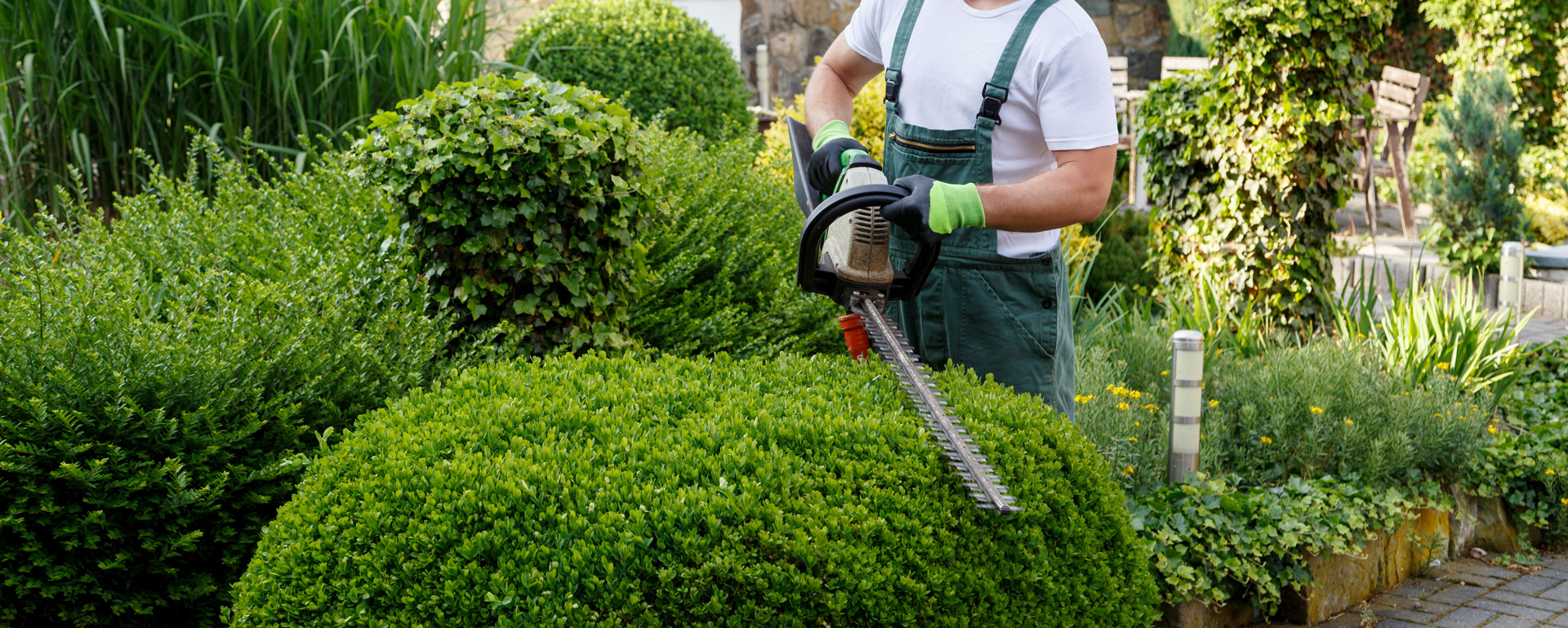Recognizing the Comprehensive Extent of Functions in Specialist Landscape Design Services
The substantial extent of specialist landscape design services incorporates a selection of fundamental aspects - landscaping. It consists of landscape style principles, plant choice, and hardscaping attributes. Furthermore, it addresses irrigation systems and maintenance methods. Each aspect plays a vital duty in producing functional and visually pleasing outside spaces. Recognizing how these components interact can reveal much about the art and scientific research of landscape design. Nevertheless, the trip right into this detailed area is just starting
Landscape Style Principles
Reliable landscape layout principles are important for producing unified exterior areas that improve both visual allure and performance (Learn More). These principles lead the arrangement of elements within the landscape, guaranteeing a cohesive aesthetic experience. Key parts consist of balance, which disperses visual weight evenly; proportion, which relates the size of different components to each various other and the area; and unity, which creates a sense of wholeness via regular motifs and products

Plant Option and Setup
In the domain of expert landscaping, plant choice and setup play a vital duty in attaining a flourishing garden. Emphasizing indigenous plant benefits, seasonal considerations, and the particular dirt and sunlight needs of each varieties ensures a sustainable and cosmetically pleasing landscape. Careful planning in these locations not only improves biodiversity yet additionally advertises long-term ecological wellness.
Indigenous Plant Benefits
Why should property owners take into consideration indigenous plants for their landscaping projects? Native plants provide many advantages that improve both aesthetic appeals and environmental sustainability. They are well-adapted to local climates, needing less water and maintenance contrasted to non-native types. This strength reduces the demand for chemical plant foods and pesticides, advertising a healthier community. Furthermore, native plants give environment and food for neighborhood wild animals, consisting of pollinators, which can increase biodiversity in suburbs. Their experience with local dirt and climate condition additionally causes much better development rates and longevity. By picking indigenous plants, house owners not just produce aesthetically attractive landscapes however additionally add to ecological preservation, making a positive influence on their local setting. Native plants stand for a smart selection for landscaping projects.
Seasonal Plant Considerations
Homeowners that have welcomed indigenous plants in their landscaping can additionally enhance their outdoor rooms by thinking about seasonal plant selections. By integrating plants that flourish in details periods, they can produce visually appealing and dynamic landscapes throughout the year. Spring may introduce vibrant blossoms like tulips and daffodils, while summer season can showcase lush vegetation and colorful perennials. Fall presents a palette of cozy tones with goldenrods and asters, while winter can be emphasized with evergreens and ornamental lawns for texture. Expert landscaping companies commonly advise selecting plants that not just complement existing native types yet also provide year-round interest and support regional wildlife. This thoughtful strategy to seasonal plant selection ensures a continuously developing and sustainable garden environment.
Dirt and Sunshine Requirements
Successful landscaping depends upon comprehending the certain soil and sunshine needs of plants. Various species thrive under differing conditions, requiring a careful evaluation of both elements during the option procedure. Dirt kinds, such as sandy, clay, or fertile, impact water drainage, nutrition schedule, and root advancement. In addition, pH levels can impact plant wellness, demanding dirt screening to ascertain viability. Sunlight demands differ substantially; some plants grow in complete sun, while others favor complete or partial color. A professional landscaper considers these components to guarantee peak growth and aesthetic allure. By aligning plant options with the environment's certain characteristics, landscapes can attain sustainability, resilience, and aesthetic harmony, inevitably resulting in successful plant facility and long-term maintenance.
Hardscaping Functions and Construction

While landscape design typically evokes images of rich plant and vibrant flowers, hardscaping attributes play a vital role in defining outdoor rooms. These elements, that include patio areas, pathways, keeping walls, and ornamental stonework, supply framework and performance to yards and yards. Hardscaping uses products such as concrete, rock, block, and wood, permitting diverse layouts that match the natural landscape.
The building of hardscaping functions requires careful preparation and implementation to guarantee durability and visual charm. Professionals assess website problems, water drainage, and spatial connections to create cohesive outside settings. Appropriate installment techniques are critical, as they prevent problems like erosion and moving with time.
Incorporating hardscaping not just improves the aesthetic rate of interest of a home however also facilitates outdoor activities, making it an essential facet of detailed landscaping services. Eventually, thoughtful hardscaping contributes to both the functionality and elegance of outside areas.
Watering Equipments and Water Monitoring
Efficient irrigation systems and water management are important parts of professional landscape design, as they guarantee that plants receive the needed hydration for perfect growth. These systems can vary from straightforward drip watering setups to innovative automated automatic sprinkler, created to meet the details demands of varied landscapes. Appropriate water monitoring not just enhances water usage, lowering waste, however also improves plant health and wellness and decreases illness threats.
Landscape design specialists examine numerous variables, consisting of soil kind, plant varieties, and local climate, to develop customized irrigation options. In addition, integrating rainwater harvesting strategies can better enhance sustainability and efficiency. Normal maintenance of watering systems is important to keep functionality and stop leakages, which can lead to water loss and increased expenses (Learn More). Inevitably, a well-designed irrigation system plays a pivotal duty in maintaining the aesthetic appeal of outside rooms while promoting eco-friendly stewardship within professional landscape design practices
Grass Care and Maintenance Methods
Lawn care and upkeep strategies are essential for accomplishing a lavish, healthy yard that improves the overall landscape. These strategies incorporate different practices intended at advertising suitable growth and visual charm. Routine mowing is necessary, as it motivates thick, also growth while avoiding weeds from developing. Furthermore, proper fertilization offers required nutrients, with applications tailored to the details turf type and dirt conditions.
Watering methods ought to concentrate on deep, seldom irrigation to encourage origin advancement, while oygenation boosts soil structure and advertises nutrient absorption. Bug and illness monitoring is likewise crucial; identifying issues early permits reliable treatments that minimize damages.
Overseeding can revitalize thin or broken lawns, improving thickness and shade (landscaping). By carrying out these targeted lawn treatment techniques, landscaping specialists can ensure that lawns continue to be vivid and healthy and balanced throughout the periods, considerably contributing to the general charm of the home
Seasonal Landscape Care and Upkeep
As the seasons change, appropriate landscape care becomes crucial for keeping click over here now the health and wellness and elegance of outside rooms. Each period offers special challenges and needs. In springtime, landscape experts concentrate on pruning, growing, and fertilizing to motivate development. Summer season demands routine watering, weed control, and bug management to safeguard recently developed plants.

Throughout the year, seasonal landscape upkeep guarantees that outdoor areas continue to be healthy and balanced and visually enticing. Expert services can give tailored maintenance strategies that adjust to the certain demands of each period, permitting homeowner to enjoy dynamic landscapes year-round. On the whole, seasonal treatment is an essential aspect of professional landscaping that advertises longevity and aesthetic value.

Lasting Landscape Design Practices
A growing number of building owners are accepting sustainable landscaping techniques to produce eco-friendly outside areas. These practices concentrate on preserving resources, enhancing biodiversity, and minimizing ecological influence. Indigenous plants are often chosen for their low water requirements and compatibility with neighborhood communities, decreasing the demand for chemical plant foods and chemicals. Rainfall gardens and absorptive paving are employed to handle stormwater runoff, advertising groundwater recharge and reducing disintegration.
Additionally, sustainable landscaping includes natural horticulture techniques that prioritize soil wellness and advertise natural parasite control. Effective irrigation systems, such as drip irrigation and rainwater harvesting, aid maximize water usage. In addition, landscape developers significantly advocate for using recycled products, such as redeemed timber and stones, to lessen waste. By embracing these sustainable practices, homeowner not only add to ecological preservation however also develop cosmetically pleasing settings that can prosper with very little upkeep.
Frequently Asked Inquiries
The length of time Does a Landscape Design Task Commonly Require To Complete?
Generally, a landscaping task can take anywhere from a few days to a number of weeks to complete, relying on the task's intricacy, layout, and size demands. Elements such as weather and source schedule likewise influence timelines.
What Variables Impact the Price of Landscaping Services?
Different aspects influence landscaping service costs, including task size, layout intricacy, material high quality, labor expenditures, geographic area, and seasonal demand. Each element adds uniquely to the total monetary requirements of a landscape design task.
Are Landscape Design Services Available Year-Round?
Landscaping services are usually readily available year-round, although availability might vary based upon area, seasonal weather, and details service offerings. Some services could be restricted throughout extreme climate or off-peak seasons.
Do Landscaping Business Deal Service Warranties on Their Work?
Several landscaping business do provide warranties on their job, which can vary in size and protection. Customers are encouraged to ask about particular terms, guaranteeing they understand what is ensured and any kind of conditions that apply.
Can I Layout My Landscape Without Professional Help?
Yes, individuals can create their landscapes without professional aid. They may lack experience in plant selection, design, and ecological considerations, potentially leading to less effective styles that can require expensive modifications later on.
In the domain name of professional landscape design, plant selection and installation play an essential function in accomplishing a growing yard. Homeowners who have actually embraced native plants in their landscape design can additionally improve their outdoor rooms by thinking about seasonal plant options. Effective landscape design hinges on comprehending the specific dirt and sunshine needs of plants. Efficient irrigation systems and water monitoring are essential elements of specialist landscaping, as they assure that plants get the required hydration for excellent development. Landscape design experts evaluate numerous aspects, consisting of dirt type, plant varieties, and regional climate, to develop customized irrigation options.